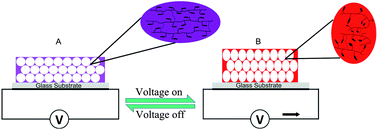In this article, a new type of electrothermally driven photonic crystal based on liquid crystal elastomers (LCEs) was developed, and its optical properties (structural colour) driven by voltage were described. Graphite nanoparticles were spin-coated on glass-substrates and acted as an electrothermal conversion layer, on which the prepared LCE-based inverse opaline films were mounted. When voltage is applied on the fabricated system, the heat produced by the graphite layer will induce the deformation of the coated inverse opaline film and thus the electrothermally driven photonic system or structural colour is realized. We found that realignment behaviour existed when these films were first above their glass transition temperatures (Tg), and during this realignment process, the structural colour of weakly crosslinked inverse opaline films disappeared, probably due to the collapse of the periodically ordered porous structure. The threshold cross-linking density (Cx) for producing LCE-based inverse opalines with reversible response is 25 mol%. Interestingly, it is found that the treatment of the prepared photonic films by using silicone oil could reduce the threshold Cx to 15 mol%, and the fabrication of LCE-based inverse opaline with widely tunable optical properties is possible. When the temperature of the used electrothermal conversion layer is close to the nematic–isotropic (N–I) transition temperature (TNI) of the LCE films, the liquid crystal moieties in inverse opaline structure became isotropic, leading to rapid shift of the Bragg-diffraction peak and corresponding structural colour change. After turning off the voltage, they could regain to the initial state. With the decrease of the cross-linking density of the photonic-structured elastomers, the degree of Bragg-diffraction shift became larger. Remarkably, the response of these films stimulated by electric voltage is fast and the reversibility is perfect.

You have access to this article
 Please wait while we load your content...
Something went wrong. Try again?
Please wait while we load your content...
Something went wrong. Try again?


 Please wait while we load your content...
Please wait while we load your content...